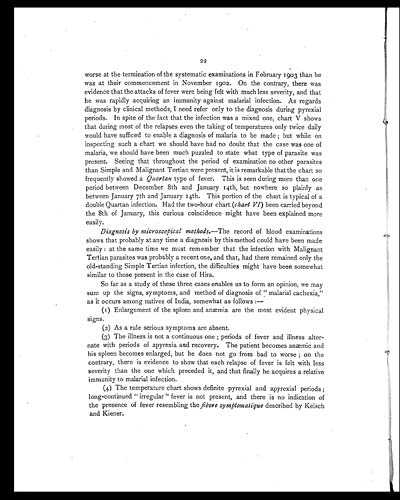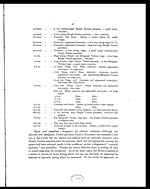Medicine - Institutions > Army health reports and medical documents > Scientific memoirs by officers of the Medical and Sanitary Departments of the Government of India > Number 19 - On kala azar, malaria and malarial cachexia > On kala azar, malaria and malarial cachexia
(30) Page 22
Download files
Individual page:
Thumbnail gallery: Grid view | List view

22
worse at the termination of the systematic examinations in February 1903 than he
was at their commencement in November 1902. On the contrary, there was
evidence that the attacks of fever were being felt with much less severity, and that
he was rapidly acquiring an immunity against malarial infection. As regards
diagnosis by clinical methods, I need refer only to the diagnosis during pyrexial
periods. In spite of the fact that the infection was a mixed one, chart V shows
that during most of the relapses even the taking of temperatures only twice daily
would have sufficed to enable a diagnosis of malaria to be made; but while on
inspecting such a chart we should have had no doubt that the case was one of
malaria, we should have been much puzzled to state what type of parasite was
present. Seeing that throughout the period of examination no other parasites
than Simple and Malignant Tertian were present, it is remarkable that the chart so
frequently showed a Quartan type of fever. This is seen during more than one
period between December 8th and January 14th, but nowhere so plainly as
between January 7th and January 14th. This portion of the chart is typical of a
double Quartan infection. Had the two-hour chart (chart VI) been carried beyond
the 8th of January, this curious coincidence might have been explained more
easily.
Diagnosis by microscopical methods.—The record of blood examinations
shows that probably at any time a diagnosis by this method could have been made
easily: at the same time we must remember that the infection with Malignant
Tertian parasites was probably a recent one, and that, had there remained only the
old-standing Simple Tertian infection, the difficulties might have been somewhat
similar to those present in the case of Hira.
So far as a study of these three cases enables us to form an opinion, we may
sum up the signs, symptoms, and method of diagnosis of " malarial cachexia,"
as it occurs among natives of India, somewhat as follows :—
(1) Enlargement of the spleen and anæmia are the most evident physical
signs.
(2) As a rule serious symptoms are absent.
(3) The illness is not a continuous one; periods of fever and illness alter-
nate with periods of apyrexia and recovery. The patient becomes anæmic and
his spleen becomes enlarged, but he does not go from bad to worse; on the
contrary, there is evidence to show that each relapse of fever is felt with less
severity than the one which preceded it, and that finally he acquires a relative
immunity to malarial infection.
(4) The temperature chart shows definite pyrexial and apyrexial periods ;
long-continued " irregular " fever is not present, and there is no indication of
the presence of fever resembling the fièvre symptomatique described by Kelsch
and Kiener.
Set display mode to: Large image | Zoom image | Transcription
Images and transcriptions on this page, including medium image downloads, may be used under the Creative Commons Attribution 4.0 International Licence unless otherwise stated. ![]()
| Permanent URL | https://digital.nls.uk/75027563 |
|---|
| Shelfmark | IP/QB.10 |
|---|---|
| Additional NLS resources: | |




